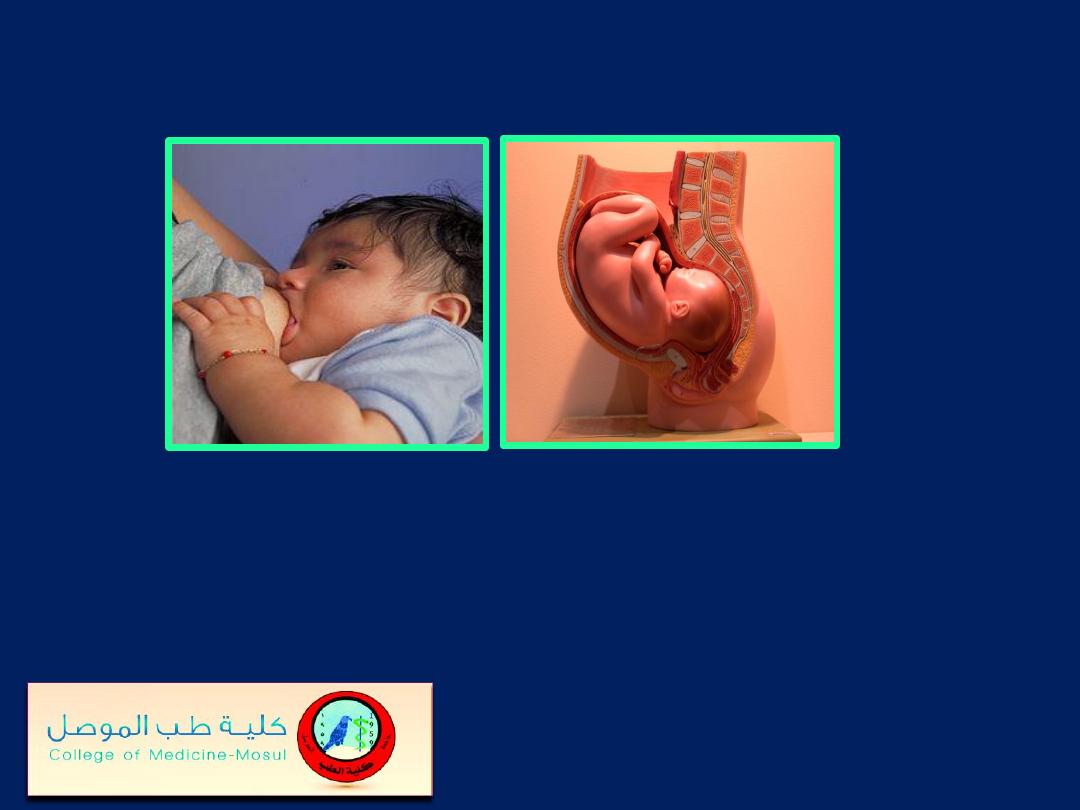
Medical Disorders and Drug Use during
Pregnancy and breast feeding
Hussein Mohammed Jumaah
CABM
Lecturer in internal medicine
Mosul College of Medicine
2016

Medical Disorders and Drug Use during
Pregnancy and breast feeding
Goals
At the end of this talk, you will be able to:
1. Confidently prescribe needed medications
during Pregnancy and breast feeding .
2. Order diagnostic imaging safely for
pregnant .
3. Act on evidence-based recommendations

Medical Disorders during Pregnancy
Introduction
Each year, approximately more than 130 million births
occur worldwide. A significant proportion of these are
complicated by medical disorders. In the past, many
medical disorders were contraindications to pregnancy.
Advances in obstetrics, neonatology, obstetric
anesthesiology, and medicine have increased the
expectation that pregnancy will result in a positive
outcome for both mother and fetus.

Most information about drug safety during pregnancy is derived
from animal
studies and uncontrolled studies in people (eg, postmarketing reports). Despite
widespread concern about drug safety, exposure to therapeutic drugs accounts for
only 2 to 3% of all fetal congenital malformations; most malformations result from
genetic, environmental, or unknown causes.
A drug’s effect on the fetus is determined largely by fetal age at exposure,
drug potency, and drug dosage.
Fetal age affects the type of drug effect:
Before the 20th day
after fertilization : Drugs have an all-or-nothing effect, killing
the embryo or not affecting it at all.
During organogenesis
(between 20 and 56 days after fertilization):
Teratogenesis is most likely at this stage(spontaneous abortion, a sublethal gross
anatomic defect ) or the drugs may have no measurable effect.
After organogenesis
(in the 2nd and 3rd trimesters): Teratogenesis is unlikely, but
drugs may alter growth and function of normally formed fetal organs and tissues.

Medicine and Pregnancy (continued)
Maternal death
is defined as
death occurring during
pregnancy
or
within 42 days of completion of pregnancy
from a cause related to
or aggravated by pregnancy,
but not due to
accident or incidental
causes.
The most common causes of maternal death
in the US today are
pulmonary embolism, obstetric hemorrhage, hypertension, sepsis,
CVconditions (including peripartum cardiomyopathy), and ectopic
pregnancy.
Improved outcomes of pregnancy
will be best
attained by a team of internists, maternal-fetal medicine specialists,
and anesthesiologists assembled to counsel these patients about the
risks of pregnancy and to plan their treatment prior to conception.
The importance of preconception counseling cannot be overstated.

Medical Disorders and Drug Use during Pregnancy and
breast feeding
There are four important clinical principles
Medical disorders : Firstly, affected by the pregnancy
Secondly, may affect pregnancy.
Thirdly, diagnosis may be attributed to
physiological changes ,overdiagnosis of some medical disorders.
Finally, the treatment of medical disorders may be different (Two
patients) . The physician and the obstetrician have to balance the
risks and benefits to both. Nearly all drugs transfer into breast milk
to some extent (notable exceptions are heparin and insulin which
are too large to cross biological membranes).The volume of milk
ingested by infants is commonly estimated as 0.15L/kg/day.

Minimizing Potential Risk to Nursing Infants from Maternal
Medications
General considerations
1. Avoid drug when possible. Use topical therapy when possible.
2. Medications that are safe in pregnancy are not always safe in breast-feeding
mothers. e.g Aspirin which enters the breast milk could impair blood clotting in
susceptible babies.
3. Use reliable references for obtaining information on medications.
Medication selection
choose medications with the
1.
Shortest half-life and highest protein-binding ability. lowest lipid solubility,
that are well-studied in infants.
2.
With the poorest oral absorption.
Medication dosing
Administer single daily-dose medications just before the longest sleep interval
for the infant, usually after the bed-time feeding.
Breast-feed infant immediately before medication dose when multiple daily doses
are needed.

FDA pregnancy categories:
A:
Studies in pregnant women show no risk.
B:
Animal studies show no risk, but human data are insufficient; or
animal studies show toxicity, but human studies show no risk.
C:
Animal studies show toxicity, human data are insufficient, but
clinical benefit may exceed risk.
D:
There is evidence of human risk, but clinical benefits may
outweigh risk.
X:
There is evidence of fetal abnormalities in humans, and risk
exceeds benefits.

The U.S. Food and Drug Administration published
a final rule
that sets standards for how information about using medicines
during pregnancy and breastfeeding is presented in the
labeling of prescription drugs and biological products,
referred
to as the "Pregnancy and Lactation Labeling Rule"
(PLLR or final rule).
The final rule replaces
the current product letter categories - A,
B, C, D and X - used to classify the risks of using prescription
drugs during pregnancy .
The new labeling rule provides for explanations, based on
available information, about the potential benefits and risks for
the mother, the fetus and the breastfeeding child

Medicine and Pregnancy (continued)
Blood volume increases greater than the increase in red blood cell
mass, ( “anemia of pregnancy”).
Cardiac output rises peaking by the end of the second trimester
and reaching a plateau until delivery. Stroke volume declines in the
third trimester because of inferior vena caval compression by the
uterus.
The increase in cardiac output is achieved by three factors:
1) Increase in preload ,greater blood volume;
2) Reduced afterload , decrease in systemic vascular resistance;
and
3) Rise in heart rate by 10-15 beats/min during the third trimester.

Medicine and Pregnancy (continued)
During labor and delivery, hemodynamic fluctuations can be
profound.
Each uterine contraction displaces 300 to 500 mL of blood
into the general circulation. Stroke volume increases, with a
resultant rise in cardiac output by an additional 50% with each
contraction..
Mean arterial pressure also rises, in part because of maternal
pain and anxiety.
Blood loss during delivery (300 to 400 mL for a vaginal
delivery and 500 to 800 mL for a cesarean section) can
contribute to hemodynamic stress.

Medicine and Pregnancy (continued)
Hemodynamic changes
during the postpartum state. Relief of
inferior vena caval compression results in an increase in venous
return, which augments cardiac output and causes a brisk diuresis.
The hemodynamic changes return to the prepregnant baseline
within 2 to 4 weeks following vaginal delivery and within 4 to 6
weeks after cesarean section.
Even women whose blood pressure was normal throughout
pregnancy may experience transient hypertension in the early
period post partum (vasomotor instability).

Medical Disorders and Drug Use during Pregnancy and
breast feeding (continued)
Nausea and Vomiting in Pregnancy
About 50% of women have nausea and vomiting in early
pregnancy, and an additional 25% have nausea alone.
The onset is within four weeks of the LMP in most patients. peaks
at 9 weeks.
60% resolve by the end of the first trimester, 90% by 20 weeks.
Adequate oral hydration and avoidance of dietary triggers are
often sufficient, but a proportion will need antiemetic drugs.

Medical Disorders and Drug Use during Pregnancy and breast
feeding (continued)
Nausea and Vomiting in Pregnancy
It is theorized that hCG may stimulate estrogen production from
the ovary; estrogen is known to increase nausea and vomiting.
Women with twins or hydatidiform moles, who have higher hCG
levels than do other pregnant women, are at higher risk for these
symptoms. Another theory is that vitamin B deficiency may
contribute, since the use of vitamin B reduces the incidence of
nausea and vomiting.

Medical Disorders and Drug Use during Pregnancy and breast
feeding (continued)
Incidence of hyperemesis gravidarum
Is 0.3 to
1.0%;
characterized by persistent vomiting, weight loss
of more than 5%,
ketonuria, hypokalemia,
and
dehydration,
the observation that pregnancies with a complete hydatidiform
mole (no fetus) are associated with clinically significant nausea
and vomiting indicates that
the stimulus is
produced by the
placenta,
not the fetus.

Medical Disorders and Drug Use during Pregnancy and breast
feeding (continued)
Preventable rare maternal complications of hyperemesis
gravidarum include
1. peripheral neuropathies due to vitamin B6 and B12
deficiencies.
2. Wernicke’s encephalopathy due to thiamine (B1) deficiency.
Characterized by the triad of ophthalmoplegia, ataxia, and
confusion, may occur after at least 3 weeks of persistent
vomiting.
If patients are treated with intravenous dextrose without
thiamine, metabolism of the dextrose rapidly consumes
the available B1, triggering acute encephalopathy.

Medical Disorders and Drug Use during Pregnancy and breast
feeding (continued)
Hyperemesis gravidarum
Hyperemesis gravidarum must be distinguished from
other
causes of persistent vomiting in pregnancy, including appendicitis,
hepatitis, pancreatitis, biliary tract disease, pyelonephritis, diabetic
ketoacidosis, or Addison’s disease.
Laboratory testing
urinary ketones, urea, creatinine, aminotransferase,
electrolytes, amylase, and free thyroxine.
Because hCG cross-reacts with thyrotropin and stimulates the
thyroid gland, thyrotropin is typically suppressed in these patients.
This apparent hyperthyroidism usually resolves spontaneously.

Medical Disorders and Drug Use during Pregnancy and
breast feeding (continued)
Nausea and Vomiting in Pregnancy
Management
Avoid exposure to odors, foods that trigger nausea, fatty or spicy
foods and iron tablets. Eating small amounts of food several times a
day and drinking fluids between meals may be helpful, as may
bland, dry, and high-protein foods.Women who have persistent
nausea and vomiting and high concentrations of ketones require
intravenous hydration with multivitamins, including thiamine.B
6
and
antihistamine
doxylamine
(70% reduction in nausea and
vomiting)recommended as
first-line
therapy.
Phenothiazine or
metoclopramide
prescribed if antihistamines fail. Metoclopramide is
a prokinetic agent,a dopamine antagonist,associated in rare cases
with tardive dyskinesia.

Medical Disorders and Drug Use during Pregnancy and
breast feeding (continued)
Nausea and Vomiting in Pregnancy
Management
The 5-hydroxytryptamine3-receptor antagonists, such as
ondansetron (Zofran), are increasingly used.
Methylprednisolone is an option in refractory cases. Because of
glucocorticoids before 10 weeks of gestation was associated with a
risk of cleft lip with or without cleft palate, thus, it is recommended
that glucocorticoids be used only after 10 weeks of gestation.
Randomized trials have provided support for a benefit of ginger
and acupuncture.
Management of Refractory Cases
Require intravenous hydration and nutritional supplementation.
Enteral tube feeding may be effective.

Medical Disorders and Drug Use during Pregnancy and
breast feeding (continued)
Nausea and Vomiting in Pregnancy
Management
Total parenteral nutrition
is associated with a substantial risk of
line sepsis (25%), steatohepatitis may also occur with the use of
lipid emulsion,
so it should be reserved
for patients with
significant weight loss
(>5% of body weight) and
no response to antiemetic
regimens and
whose condition cannot
be managed with enteral feedings.

HEART DISEASE & PREGNANCY
Women with a history of prior MI, PCI, or CABG should be
counseled ,advised about the potential complications than can
occur and should consider other ways of becoming a mother—
adoption, surrogacy, fostering.
An LVEF> 40% and a good response to exercise testing likely
portend a good outcome, although complications can still occur.
The combined oral contraceptive pill (containing estrogen) is
associated with an increased risk of thromboembolism and is
contraindicated in CAD.
Progesterone-only forms are not associated with thromboembolic
risk and can be suitable alternatives.

ECG changes in pregnancy
ECG readings are altered because the heart is pushed up and
rotated by the gravid uterus.
Normal ECG findings can include:
1.
Atrial and ventricular ectopics
2.
Small Q waves and inverted T waves in lead III
3.
ST depression and T wave inversion in inferior and lateral leads
4.
Left shift in QRS axis.
Normal pregnancy is typically associated with fatigue, dyspnea,
and decreased exercise capacity. Pregnant women usually have
mild peripheral edema and jugular venous distention. Most
pregnant women have audible physiologic systolic murmurs,
created by augmented blood flow. A physiologic (S
3
), reflecting the
increased blood volume, can sometimes be auscultated.

HEART DISEASE & PREGNANCY
Contraindications to pregnancy include
1. Severe pulmonary hypertension or Eisenmenger's
syndrome,
2. Cardiomyopathy with NYHA Class III or IV, history
of peripartum cardiomyopathy,
3. Severe uncorrected valvular stenosis,
4. Unrepaired cyanotic congenital heart disease
5. Marfan syndrome with an abnormal aorta.

HEART DISEASE & PREGNANCY
Coronary Artery Disease
AMI during pregnancy is rare, occurring in 1 in 35,000 pregnancies.
Mostly occur during the third trimester in women older than 33 years
who have had multiple prior pregnancies. Coronary spasm, in situ
coronary thrombosis, and coronary dissection occur more frequently
than classic obstructive atherosclerosis. Troponins are preferred to
CK for the diagnosis (physiological increase in CK levels during
labor and delivery).
The treatment of pregnant with an STEMI and its potential
complications should follow the usual standard of care.

HEART DISEASE & PREGNANCY
Heart attack
Fortunately, it is rare for, premenopausal—to have
arteriosclerotic heart disease, but it is possible among older
pregnant women. The impact of preexisting cardiovascular risk
factors on the mother and fetus are profound.
Treatment must be aimed at saving the life of the mother, no
matter what the stage of gestation.
Cardiac catheterization may result in fetal exposure to
radiation.
The 8th to 15th week of gestation is the most radiation-
sensitive period for the fetus, appropriate shielding of the fetus
is important.

HEART DISEASE & PREGNANCY
PCI , stenting has been successfully performed in pregnant with AMI,
with the use of lead shielding to protect the fetus.
Medical therapy for (AMI) must be modified. Although
thrombolytic agents, relatively contraindicated, increase the risk
of maternal hemorrhage substantially (8%), their use is permitted
for situations in which cardiac catheterization facilities are not
available.
Low-dose aspirin, beta blockers ,nitrates and Short-term heparin
are considered safe.
ACE inhibitors and statins are contraindicated. Hydralazine and
nitrates may be used as substitutes for ACE inhibitors.
Clopidogrel and glycoprotein IIb/IIIa receptor inhibitors have been
used safely in pregnant .

HEART DISEASE & PREGNANCY
Labour and delivery
Because of the increased hemodynamic stress it has been
recommended that induction of labour or cesarean be delayed, if
possible, for at least two to three weeks after an
acute MI
. Delivery
should be planned carefully with a multidisciplinary team. Generally,
vaginal deliveries are recommended unless there are obstetric
indications for a cesarean.
Good pain management for delivery is very important to minimize
maternal cardiac stress.
Post Partum Care
There is associated with a large hemodynamic load because of
enhanced venous return with relief of caval compression and blood
from the contracting emptied uterus.

Hypertension
Blood pressure should be measured in the sitting position,
cuff at the level of the heart. Inferior vena caval
compression by the gravid uterus while the patient is
supine leading to an underestimation of the blood
pressure., left lateral position similarly may yield falsely
low values if the blood pressure is measured in the higher
arm, unless the cuff maintained at the level of the heart.
The diagnosis of hypertension requires the measurement of
two elevated blood pressures, at least 6 h apart. A blood
pressure of 140/90 mmHg is considered to be abnormally
elevated and is associated with an increase in perinatal
morbidity and mortality.

Medical Disorders and Drug Use during
Pregnancy and breast feeding (continued)
Hypertension
is the
most common medical problem
seen
in pregnancy (15%). In pregnancy, cardiac output
increases by 40%, most of which is due to an increase in
stroke volume. Heart rate increases by ~10 beats/min
during the third trimester. In the second trimester, systemic
vascular resistance decreases and this is associated with a
fall in blood pressure.
Hypertension during pregnancy is usually caused by
preeclampsia, chronic hypertension, gestational
hypertension, or renal disease.

Chronic essential hypertension
Increase the risk for preeclampsia , abruptio placentae, intrauterine
growth restriction and increased perinatal mortality.
The target
blood pressure is in the range of 130–150 mmHg
systolic and 80–100 mmHg diastolic. Lowering too much may lead
to placental hypoperfusion because placental blood flow is not
autoregulated. Unfortunately there is no evidence that treating
hypertension protects against the development of preeclampsia but
reduce the incidence of maternal intracranial haemorrhage.
Some women with mild treated pre-existing hypertension are able
to stop their medication in the first half of pregnancy because of
the physiological fall in blood pressure. But should be monitored.

Occurs in 5% to 8%. Although the precise
pathophysiology remains unknown, recent studies show
excessive placental production of antagonists to both
vascular epithelial growth factor (VEGF) and
transforming growth factorβ (TGF-β) (endoglin), these
disrupt endothelial and renal glomerular function
resulting in edema, hypertension, and proteinuria, and
widespread endothelial dysfunction with multiorgan
system clinical features.
Preeclampsia-eclampsia

Medical Disorders and Drug Use during Pregnancy and
breast feeding
Risk factors for the development of preeclampsia
1. Nulliparity,
2. Diabetes mellitus,
3. A history of renal disease or
4. Chronic hypertension,
5. A prior history of preeclampsia,
6. Extremes of maternal age (>35 years or <15 years),
7. Obesity,
8. Antiphospholipid antibody syndrome, and
multiple gestation.
Low-dose aspirin (81 mg daily, initiated at the end
of the first trimester) may reduce the risk of preeclampsia in
pregnant women at high risk of developing the disease.

Preeclampsia
Occurs
after 20 weeks
,a multisystem disorder.
Affect approximately
5–7% of all pregnant
, with respect to preeclampsia several
pertinent
revisions
to the diagnostic criteria were made including:
proteinuria is no longer an absolute
requirement for making the
diagnosis; the terms mild and severe preeclampsia have been
replaced, and the disease is now termed preeclampsia either with or
without severe features;
removal of fetal growth restriction as a
defining criterion
for severe preeclampsia.
Gestational hypertension
The development of elevated blood pressure
in
the second half of
pregnancy or in the first 24 h post-partum in the absence of
preexisting chronic hypertension or proteinuria and returns to normal
by six weeks after birth.

Women with gestational hypertension or pre-eclampsia are
usually able to stop antihypertensives within six weeks after birth..
women who breast feed should avoid diuretics because they can
increase thirst.
Proteinuria in pre-eclamptic women will usually resolve by three
months post partum .
Breast feeding
You can give most antihypertensive drugs
Propranolol , metoprolol and labetalol excreted in small
quantities and are safe. Atenolol ,nadolol and sotalol are excreted
in higher amounts, can lead to hypotension, bradycardia and
tachypnea in the infant. it is preferable to avoid high dosages of
any one.

The definitive treatment of preeclampsia
with severe features
is
delivery
of the fetus and placenta, aggressive management of
blood pressures >160/110 mmHg reduces the risk of
cerebrovascular accidents.
IV labetalol or hydralazine
is most commonly used to acutely
manage severe hypertension in preeclampsia; labetalol is
associated with fewer episodes of maternal hypotension.
Oral
nifedipine
may also be used. You should give hydralazine only after
giving intravenous fluid: this reduces the reflex tachycardia, and
abrupt hypotension. Elevated arterial pressure should be
reduced
slowly to avoid
hypotension and a decrease in blood flow to the
fetus. Magnesium sulfate is the preferred agent for the prevention
and treatment of eclamptic seizures.

First line drugs
Methyldopa
can cause
sedation; may cause liver transaminases to
rise (5%) or a positive Coomb's test (although haemolytic anaemia
is uncommon), increased risk of postnatal depression.
With the development
of newer antihypertensives, long records of
safe use in pregnancy, and with improved methods of fetal
surveillance, we no longer recommend -methyldopa as first-line.
Second line drugs
Labetalol This is used by some as a first line. Since beta blockers
have been associated with growth restriction when used from the
first trimester, our preference is to avoid labetalol until later in
pregnancy. Nifedipine safe. avoid sublingual (placental
hypoperfusion). Amlodipine has been used in pregnancy.
Oral hydralazine Safe, although there have been reports of lupus-
like syndromes in the mother and neonate.

Third line drugs
You should avoid
ββ
in the first half of pregnancy because of
concerns about growth restriction.
Alpha β : Prazosin , doxazosin
are safe
Thiazide diuretics
Although they reduce plasma volume, this has not been proved
to impair fetal growth, reserved for cardiac disease and
pulmonary oedema.
Spironolactone is
not
recommended,
antiandrogenic.
may lead to
hyperuricemia
and invalidate serum uric acid
levels as a laboratory marker in the diagnosis of preeclampsia.

Drug treatment
All antihypertensive drugs cross the placenta
and reach the fetal circulation. Most are not
teratogenic, although ACE inhibitors and
angiotensin receptor blockers are, and should be
avoided.
A teratogenic substance is one that interferes with the formation of major body structures during
the first trimester, during the period of organogenesis
A fetotoxic drug interferes with the subsequent growth and development of the fetus

Medical Disorders and Drug Use during Pregnancy and
breast feeding
Heart valve disease
This is the most common cardiac problem complicating pregnancy.
The physiological changes systemic vasodilation and a fall in
peripheral vascular resistance, So regurgitation is generally better
tolerated than stenosis ((limits the physiological increase in
cardiac output)) provided that there is no associated left
ventricular dysfunction.
Mitral stenosis :
The most likely valvular disease to cause
pulmonary oedema and death during pregnancy (increase in
cardiac output, tachycardia can increase the transmitral pressure
gradient) particularly occurs during the third trimester or
immediately after delivery.
Aortic stenosis :
syncope, exertional dyspnoea, or chest pain.

Medical Disorders and Drug Use during Pregnancy and
breast feeding
Mitral Stenosis
This is the valvular disease most likely to cause death during
pregnancy. The pregnancy-induced increase in blood volume,
cardiac output, and tachycardia can increase the transmitral
pressure gradient and cause pulmonary edema in women with
mitral stenosis.
Women with moderate to severe mitral stenosis who are planning
pregnancy and have either symptomatic disease or pulmonary
hypertension should undergo valvuloplasty prior to conception.
Pregnancy associated with long-standing mitral stenosis may result
in pulmonary hypertension.
Sudden death has been reported when hypovolemia occurs.

Medical Disorders and Drug Use during Pregnancy
and breast feeding
Mitral Stenosis
Careful control of heart rate, especially during labor and
delivery, minimizes the impact of tachycardia and reduced
ventricular filling times on cardiac function. Pregnant women with
mitral stenosis are at increased risk for the development of atrial
fibrillation and other tachyarrhythmias.
Medical management of severe mitral stenosis
and atrial
fibrillation with digoxin and beta blockers is recommended.
Balloon valvulotomy can be carried out during pregnancy.
The immediate postpartum period
is a time of particular
concern secondary to rapid volume shifts. Careful monitoring of
cardiac and fluid status should be observed.

Medical Disorders and Drug Use during Pregnancy and
breast feeding
Heart valve disease
Medical treatment
Aortic stenosis :
Beta blockers to treat symptoms like chest pain, syncope, and
dyspnoea, avoiding vasodilators.
Mitral stenosis :
Increased risk of atrial fibrillation and tachyarrhythmias. digoxin and
beta blockers.
Diuretics to control pulmonary oedema .
Thromboprophylaxis in patients with an enlarged left atrium.
Balloon valvulotomy can be carried out during pregnancy.

Medical Disorders and Drug Use during Pregnancy
and breast feeding
Mitral Regurgitation and Aortic Regurgitation and Stenosis
The pregnancy-induced decrease in systemic vascular resistance
reduces the risk of cardiac failure with these conditions.
As a rule, mitral valve prolapse does not present problems for
the pregnant patient, and aortic stenosis, unless very severe, is
well tolerated. In the most severe cases of aortic stenosis,
limitation of activity or balloon valvuloplasty may be indicated.

Medical Disorders and Drug Use during Pregnancy and breast
feeding
Pulmonary Hypertension
Maternal mortality in the setting of severe pulmonary hypertension
is high, and primary pulmonary hypertension is a contraindication
to pregnancy.
Termination of pregnancy may be advisable
in these
circumstances to preserve the life of the mother.
In the Eisenmenger syndrome, i.e., the combination of pulmonary
hypertension with right-to-left shunting due to congenital
abnormalities ,maternal and fetal death occur frequently.

Medical Disorders and Drug Use during Pregnancy and
breast feeding
CONGENITAL HEART DISEASE
Reparative surgery has markedly increased the number of women
with surgically repaired congenital heart disease.
Maternal morbidity and mortality are greater among these women
than among those without surgical repairs. When pregnant, these
patients should be jointly managed by a cardiologist and an
obstetrician familiar with these problems. The presence of a
congenital cardiac lesion in the mother increases the risk of congenital
cardiac disease in the newborn. Prenatal screening of the fetus for
congenital cardiac disease with ultrasound is recommended.

Medical Disorders and Drug Use during Pregnancy and
breast feeding
Congenital Heart Disease
Atrial or ventricular septal defect
is usually well tolerated during
pregnancy in the absence of pulmonary hypertension. Use of air
filters on IV sets during labor and delivery in patients with
intracardiac shunts is generally recommended.
Supraventricular tachycardia
Treatment is the same as in the nonpregnant adenosine and calcium
channel blockers.
Electrocardioversion may be performed and is generally well
tolerated by mother and fetus.

Medical Disorders and Drug Use during Pregnancy and breast
feeding
Deep Venous Thrombosis and Pulmonary Embolism
Is one of the most common causes of maternal death .
Overall, the rate of first VTE during pregnancy was four times
higher than the rate in nonpregnant women.
Hyperemesis gravidarum doubled risk for VTE.
A hypercoagulable state ((increase in procoagulants such as
factors V and VII, and a decrease in anticoagulant activity,
including proteins C and S)) is characteristic of pregnancy.
DVT more
in the
left leg,
due to the compression of the left iliac
vein by the iliac artery and the uterus. 25% of women with DVT
during pregnancy carry the factor V Leiden allele.

Medical Disorders and Drug Use during Pregnancy
and breast feeding
Deep Venous Thrombosis
Aggressive diagnosis and management of DVT and
suspected pulmonary embolism optimize the outcome
for mother and fetus. In
general, all diagnostic and therapeutic modalities
afforded the nonpregnant patient should be utilized in
pregnancy
except for d-dimer
measurement, in which
values are elevated in normal pregnancy.

Medical Disorders and Drug Use during Pregnancy and breast
feeding
Anticoagulant therapy
with LMWH or unfractionated heparin is
indicated in pregnant with DVT. LMWH may be associated with an
increased risk of epidural hematoma in women receiving an epidural
anesthetic in labor. Four weeks prior to anticipated delivery, LMWH
should be switched to unfractionated heparin. Warfarin therapy is
contraindicated in the first trimester due to its association with fetal
chondrodysplasia punctata. In the second and third trimesters,
warfarin may cause fetal optic atrophy and mental retardation.
When DVT occurs in the postpartum period
, LMWH therapy for
7–10 days may be followed by warfarin therapy for 3–6 months.
Warfarin is not contraindicated in breast-feeding women.
For women at moderate or high risk of DVT who have a cesarean
delivery, mechanical and/or pharmacologic prophylaxis is warranted.

Medical Disorders and Drug Use during Pregnancy
and breast feeding
Deep Venous Thrombosis
Aggressive diagnosis and management of DVT and
suspected pulmonary embolism optimize the outcome
for mother and fetus. In
general, all diagnostic and therapeutic modalities
afforded the nonpregnant patient should be utilized in
pregnancy
except for d-dimer
measurement, in which
values are elevated in normal pregnancy.

Medical Disorders and Drug Use during Pregnancy and breast
feeding
Anticoagulant therapy
with LMWH or unfractionated heparin is
indicated in pregnant with DVT. LMWH may be associated with an
increased risk of epidural hematoma in women receiving an epidural
anesthetic in labor. Four weeks prior to anticipated delivery, LMWH
should be switched to unfractionated heparin. Warfarin therapy is
contraindicated in the first trimester due to its association with fetal
chondrodysplasia punctata. In the second and third trimesters,
warfarin may cause fetal optic atrophy and mental retardation.
When DVT occurs in the postpartum period
, LMWH therapy for
7–10 days may be followed by warfarin therapy for 3–6 months.
Warfarin is not contraindicated in breast-feeding women.
For women at moderate or high risk of DVT who have a cesarean
delivery, mechanical and/or pharmacologic prophylaxis is warranted.

Medical Disorders and Drug Use during Pregnancy and
breast feeding
Peripartum cardiomyopathy
Cardiac failure, which develops: Between the last month of
pregnancy and five months post partum in the absence of an
identifiable cause or recognisable heart disease prior to the last
month of pregnancy with left ventricular systolic dysfunction.
Many patients recover completely; others are left with a
progressive dilated cardiomyopathy. Is one of the most common
causes of maternal death in the UK and United States; mortality
rate is 9% to 50%.
20% to 50% risk of recurrence in subsequent pregnancies, and if
they did not recover full cardiac function after the first episode,
patients have a risk of death of up to 20% in a future pregnancy.

Medical Disorders and Drug Use during Pregnancy and
breast feeding
left ventricular systolic dysfunction
1. Left ventricular ejection fraction <45%
2. A left ventricular end diastolic dimension of greater than 2.7
cm/m
2
of body surface area.
Pre-pregnancy counselling :
women who do not have normal baseline left ventricular function
after an episode should be counseled to avoid pregnancy.
Management of cardiomyopathy
(ACE) inhibitors should be avoided, but patients may remain on
beta blockers and some types of diuretic.
consider thromboprophylaxis, especially if there is a history of
arrhythmia or TIA.

Medical Disorders and Drug Use during Pregnancy and
breast feeding
Hyperlipidemia
Statins (category X) are contraindicated during pregnancy and
breastfeeding, Because statins interfere with the synthesis of
cholesterol, fetal harm or death may result.
Options include intensifying diet therapy and/or starting a
nonsystemic agent like a bile acid sequestrant (prevents
absorption of bile acids in the digestive system), e.g.,
cholestyramine, colestipol, or colesevelam, which are rated
pregnancy category B.

Obesity
Pregnant women who are obese have an increased risk of
stillbirth, congenital fetal malformations, gestational diabetes,
preeclampsia, urinary tract infections, and post-date deliveries.
Women contemplating pregnancy should attempt to achieve a
healthy weight prior to conception.
For morbidly obese women who have not been able to achieve
weight loss with lifestyle changes, bariatric surgery may result in
weight loss and improve pregnancy outcomes.
Following bariatric surgery, women should delay conception for
one year to avoid pregnancy during an interval of rapid
metabolic changes.

Medical Disorders and Drug Use during Pregnancy and breast feeding
(continued)
Diabetes Mellitus
In pregnancy,
the fetoplacental unit
induces major metabolic changes, the purpose
of which is to shunt glucose and amino acids to the fetus while the mother uses
ketones and triglycerides to fuel her metabolic needs.
Although pregnancy has been referred to as a state of "accelerated starvation," it is
better characterized as
"accelerated ketosis."
After an overnight fast, plasma
glucose is lower by 15–20 mg/dL than in the nonpregnant state.
This is due to the use of glucose by the fetus.
In early
pregnancy, fasting may result in circulating glucose concentrations in the
range of 40 mg/d L and may be associated with symptoms of hypoglycemia.
Plasma hydroxybutyrate and acetoacetate levels rise to two to four times normal
after a fast.
There is also maternal insulin resistance, caused in part by placental steroids, a
growth hormone variant, and lactogen.

1- 3% of pregnant
develop
diabetes
(90% gestational , between
24-28 weeks , 40% of gestational diabetes develop diabetes
within 10 years). All pregnant women should be screened for
gestational diabetes unless they are in a low-risk group,
((those <25 years of age; a BMI < 25 kg/m
2
, no maternal history of
macrosomia or gestational diabetes, and no diabetes in a first-degree relative))
Because
gestational diabetes typically occurs late in the second
trimester when the baby’s body is already formed, it does not
usually increase the risk of birth defects, but is associated with a
chance for delivering a large baby.
If not well controlled, there is an increased chance for the baby to
have hypoglycemia and breathing problems at birth, increased risk
of stillbirth (fetal death after the 20th week) and preeclampsia.

If diabetes is poorly
controlled early in the pregnancy,
there will be a risk of an early miscarriage , birth
defects, larger Babies, cesarean , immature lungs ,
preeclampsia and newborns with low sugar, low calcium,
and high bilirubin.
Preconception counseling
and treatment can reduce the
risk of congenital malformations.
1.0 mg of folic
acid daily for at least 3 months prior to
conception to minimize the risk of neural tube defects.

Management
Gestational Diabetes:
Most women can control blood glucose with diet , 10-15% may
require insulin. The goal is to
avoid
single large meals and a large
percentage of simple carbohydrates.
6 feedings per day is preferred, with 3 major meals and 3 snacks to
limit the amount of energy presented to the bloodstream at any
interval.
complex carbohydrates
, (whole grain breads and legumes)
is
preferable.
Carbohydrates no more than 50% of the diet, protein and fats
equally accounting for the remainder.
fasting glucose <100 mg/d L and 2-h post-prandial <126 mg/d L is
associated with a decreased risk of birth trauma.

Oral hypoglycemic agents (OHAs) such as glyburide and
metformin
have become more commonly utilized for managing
gestational diabetes refractory to nutritional management.
Glyburide
is minimally transported across the placenta, due to the
high plasma protein binding coupled with a short half-life. It should
not be used in the first trimester because its effects, if any, on the
embryo are unknown.
Available data indicate that OHAs, glyburide and metformin ,
may be both safe and effective alternatives to insulin,
but only in
women with gestational diabetes mellitus who cannot be adequately
treated with diet alone or simply refuse to take insulin.

The goal of insulin therapy during pregnancy
is to achieve
glucose profiles similar to those of nondiabetic pregnant women
Insulins lispro, aspart, regular and NPH are well-studied in
pregnancy and regarded as safe and efficacious.
Insulin glargine is less well-studied, and given its long
pharmacologic effect, may exacerbate periods of maternal
hypoglycemia. As pregnancy progresses, the increasing fetal
demand for glucose the progressive lowering of fasting and
between-meal blood sugar levels increases the risk of symptomatic
hypoglycemia.
Thus, the regimens must be continuously modified as the patient
progresses from the first to the third trimester and insulin resistance
rises. In a select group, use of an insulin pump may improve
control .The effectiveness of continuous subcutaneous insulin
infusion in pregnancy is well established.

Glucose monitoring
The availability of capillary glucose test strips should now be
considered the standard of care for pregnancy monitoring.
Superb glycemic control
requires
attention to both
pre and postprandial glucose levels.
Target blood glucose values
—
The American College of
Obstetricians and Gynecologists (ACOG) are:
Fasting glucose concentrations
≤95
mg/dL
One-hour postprandial glucose
no higher
than
140
mg/dL
Two-hour postprandial glucose
no higher
than
120
mg/dL
glycated
A1C ≤6
%

Because of delayed pulmonary
maturation of the fetuses of
diabetic mothers,
early delivery should be avoided unless
there is
biochemical evidence of fetal lung maturity or for the usual
obstetric indications (e.g., preeclampsia, fetal growth restriction,) or
for worsening maternal renal or active proliferative retinopathy.
Alpha-glucosidase inhibitors, are unlikely to be excreted into
breast milk in clinically significant amounts.
Glyburide has been shown to be safe in breastfeeding, it is
important to monitor the infant for signs of hypoglycemia, such as
increased fussiness or somnolence.
In women with a history of gestational diabetes, exercise, weight
loss, and treatment with metformin reduce the risk of developing
diabetes.

Medical Disorders and Drug Use during Pregnancy and breast
feeding (continued)
Infections
Bacterial Infections
The most common infections involve the urinary tract . Many
pregnant women have asymptomatic bacteriuria, most likely due
to stasis caused by progestational effects on ureteral and bladder
smooth muscle and later in pregnancy due to compression effects
of the enlarging uterus, if asymptomatic bacteriuria is left
untreated, pyelonephritis may occur. Indeed, ~75% of cases of
pregnancy-associated pyelonephritis are the result of untreated
asymptomatic bacteriuria.

Medical Disorders and Drug Use during Pregnancy and breast
feeding (continued)
Infections
Urinary tract infections
Asymptomatic bacteriuria
,If untreated frequently progresses to
acute cystitis (1-2%) and/or pyelonephritis. All should be screened
with a urine culture at the first prenatal visit. Subsequent screening
with nitrite/leukocyte esterase strips is indicated for high-risk
women, those with sickle cell trait or a history of urinary tract
infections. All women with positive screens should be treated,with
trimethoprim, a cephalosporin or nitrofurantoin. In recurrent UTI,
consider prophylactic nitrofurantoin but stop before delivery.
Consequences premature labour and low birth weight.

Medical Disorders and Drug Use during Pregnancy
and breast feeding (continued)
Infections
Urinary tract infections
Pregnant women who develop pyelonephritis need
careful monitoring, including inpatient IV antibiotic
administration due to the elevated risk of urosepsis and
acute respiratory distress syndrome in pregnancy.

Medical Disorders and Drug Use during Pregnancy and breast
feeding (continued)
Infections
Viral Infections
Herpesvirus
Associated with spontaneous abortion, prematurity, and congenital
and neonatal herpes. The risk can be reduced by prescribing
acyclovir for the last 4 weeks of pregnancy.
Herpesvirus infection in the newborn can be devastating from CNS
involvement.
It is recommended that pregnant women with active genital
herpes lesions at the time of presentation in labor be delivered by
cesarean.

Medical Disorders and Drug Use during Pregnancy and
breast feeding (continued)
Infections
Viral Infections
Herpesvirus Infection
The acquisition of genital herpes during pregnancy is
associated with spontaneous abortion, prematurity, and
congenital and neonatal herpes. Approximately 60% of
the newly infected women had no clinical symptoms.
If herpesvirus seroconversion occurred early in
pregnancy, the risk of transmission to the newborn was
very low. In women who acquired genital herpes shortly
before delivery, the risk of transmission was high.

Medical Disorders and Drug Use during Pregnancy and
breast feeding (continued)
Viral Infections
Herpesvirus Infection
in the newborn can be devastating.
Disseminated neonatal herpes carries with it high mortality
and morbidity rates from CNS involvement.
It is recommended that pregnant
with active genital
herpes lesions at the time of presentation in labor be
delivered by cesarean section.
The risk of active genital herpes lesions at term can be
reduced by prescribing
acyclovir for the last 4 weeks
of
pregnancy to women who have had their first episode of
genital herpes during the pregnancy.

Medical Disorders and Drug Use during Pregnancy and breast
feeding (continued)
Infections
Viral Infections
Cytomegalovirus Infection
50–90% of women of childbearing age have antibodies to CMV, but
only rarely does CMV reactivation result in neonatal infection. More
commonly, primary CMV infection during pregnancy creates a risk of
congenital CMV. Severe CMV disease in the newborn is characterized
most often by petechiae, hepatosplenomegaly, and jaundice.
Chorioretinitis, microcephaly, intracranial calcifications, hepatitis,
hemolytic anemia, and purpura may also develop. CNS involvement,
resulting in the development of psychomotor, ocular, auditory, and
dental abnormalities over time, has been described.
No currently accepted treatment of CMV

Medical Disorders and Drug Use during Pregnancy and breast
feeding (continued)
Infections
Viral Infections
Rubella
Rubella virus is
a known teratogen
; first-trimester rubella carries a
high risk of fetal anomalies, though the risk significantly decreases
later in pregnancy.
Congenital rubella may be diagnosed by percutaneous umbilical-blood
sampling with the detection of IgM antibodies in fetal blood.
All pregnant and all women of childbearing age should be tested for
their immune status to rubella and be immunized if necessary.
All nonpregnant who are not immune to rubella should be vaccinated.

Medical Disorders and Drug Use during Pregnancy and breast
feeding (continued)
Infections
Viral Infections
HIV Infection
Transmission of the virus to the newborn during the perinatal period.
Exposures, which increase the risk of transmission, include vaginal
delivery, preterm delivery, trauma to the fetal skin, and maternal
bleeding. High maternal viral load; low maternal CD4+ T cell count;
prolonged labor; prolonged length of membrane rupture; and the
presence of other genital tract infections, such as syphilis or herpes,
increase the risk of transmission. Advances in antiretroviral therapy
now make it possible for many pregnant women to have no
detectable viral load as they approach term.

Medical Disorders and Drug Use during Pregnancy and breast
feeding (continued)
Infections
Viral Infections
HIV Infection
Breast-feeding may also transmit HIV to the newborn and is
therefore contraindicated in most developed countries for HIV-
infected mothers.
Zidovudine (ZDV) administered during pregnancy and labor and
to the newborn reduces the risk of vertical transmission by 70% and
the newborn should also be treated after birth..
Cesarean section is associated with additional risk reduction
compared to vaginal delivery.

Medical Disorders and Drug Use during Pregnancy and breast
feeding (continued)
Viral Infections
HIV Infection :
The predominant cause of HIV infection in children is transmission
of the virus from mother to newborn during the perinatal period.
All pregnant women should be screened for HIV infection.
Factors that increase the risk
of mother-to-newborn transmission
include high maternal viral load, low maternal CD4+ T cell count,
prolonged labor, prolonged duration of membrane rupture, and
the presence of other genital tract infections,
such as syphilis or herpes.
Prior to the widespread use of antiretroviral treatment, the
perinatal transmission rate was in the range of 20%.

Medical Disorders and Drug Use during Pregnancy and breast
feeding (continued)
Viral Infections
HIV Infection :
In women with a good response to antiretroviral treatment, the
transmission rate is about 1%. Measurement of maternal plasma
HIV RNA copy number guides the decision for vaginal versus
cesarean delivery.
For women with <1000 copies of plasma HIV RNA/ml who are
receiving combination antiretroviral therapy, the risk of
transmission to the newborn is approximately 1% regardless of
mode of delivery or duration of membrane rupture.
These women may elect to attempt a vaginal birth following the
spontaneous onset of labor.

Medical Disorders and Drug Use during Pregnancy and breast
feeding (continued)
Viral Infections
HIV Infection :
For women with a viral load of ≥1000 copies/ml prior to 38
weeks of gestation, a scheduled prelabor cesarean at 38 weeks is
recommended to reduce the risk of HIV transmission to the newborn.
To reduce the risk of mother-to-newborn transmission, women with
>400 copies of HIV RNA/ml should be treated during the
intrapartum interval with zidovudine. All newborns of HIV-infected
mothers should be treated with zidovudine for 6 months after birth.
Women who are HIV positive may transmit the virus through their
breast milk. In developed countries, HIV-infected mothers are
advised not to breast-feed.

Medical Disorders and Drug Use during Pregnancy and breast
feeding (continued)
Infections
Tuberculosis (TB)
Untreated TB represents a greater hazard to a pregnant woman
and her fetus than does its treatment. Infants born to women with
untreated TB may be of lower birth weight, rarely the infant may
be born with TB.
Although the drugs used in the initial treatment regimen cross the
placenta, they do not appear to have harmful effects on the fetus.

Medical Disorders and Drug Use during Pregnancy and breast
feeding (continued)
Infections
Tuberculosis (TB)
Active TB should be treated, even in women in the first stage of
pregnancy.
Isoniazid, rifampin, and ethambutol
may be used. In
the United States,
pyrazinamide
is reserved for women with
suspected MDR-TB. Elsewhere in the world, pyrazinamide is commonly
used in pregnant women with TB.
Pyridoxine (
25 mg/day) is recommended for all women taking INH
who are either pregnant or breastfeeding.
Streptomycin, kanamycin, amikacin, capreomycin and
fluoroquinolones listed as contraindicated for use by pregnant.

Medical Disorders and Drug Use during Pregnancy and breast
feeding (continued)
Infections
Tuberculosis (TB)
How Does Maternal TB Affect Foetus and Neonate?
A foetus can get TB infection either by haematogenous spread through
umbilical vein to foetal liver or by ingestion or aspiration of
infected amniotic fluid. True congenital TB is believed to be rare, the
risk shortly after the birth is greater. A neonate having congenital TB
may present with respiratory distress, fever, poor feeding,lethargy,
irritability, abdominal distention, lymphadenopathy and hepato-
splenomegaly. An abnormal chest radiograph is found in all such cases,
half of whom have a miliary pattern. The overall mortality for
congenital TB is 38% in the untreated and 22% in the treated.

Medical Disorders and Drug Use during Pregnancy and breast
feeding (continued)
Infections
Tuberculosis (TB)
Care of neonates
Neonates born to mothers having infectious TB should be given
chemoprophylaxis with INH for 3 months or till the mother becomes
noninfectious.
BCG vaccination may be postponed or done with INH-resistant
BCG vaccine. After 3 months, if mother has a negative sputum
smear and the neonate (with a normal chest XR) has anegative
Mantoux test, then INH chemoprophylaxis may be discontinued. In
case, the Mantoux test is positive, a thorough search should be
made for locating the presence of pulmonary or extrapulmonary
focus and administration of ATTB may be decided accordingly.

Medical Disorders and Drug Use during Pregnancy and breast
feeding (continued)
Infections
Patients with congenital tuberculosis
Neonates should receive isoniazid (10 to 15 mg per kilogram of
body weight per day), rifampin (10 to 20 mg per kilogram per
day), pyrazinamide (15 to 30 mg per kilogram per day), and either
streptomycin (20 to 30 mg per kilogram per day) or ethambutol (15
to 25 mg per kilogram per day) for the first 2 months, followed by
isoniazid and rifampin for 4 to 10 months, depending on the
severity of the disease. Because of the potential for optic neuritis,
streptomycin is generally preferred over ethambutol in infants. In
communities where rates of resistance to isoniazid are 4 %, initial
regimens of three drugs may be acceptable.

Medical Disorders and Drug Use during Pregnancy and breast
feeding (continued)
Infections
Tuberculosis (TB)
Effects on Breast feeding
Use of Isoniazid, Rifampicin, Ethambutol, Pyrazinamide,
Streptomycin, Kanamycin and Cycloserine has been considered
safe for breast feeding. The effect of these drugs gets minimized,
if the mother breast feeds before taking the drugs and substitutes
the next feed with formula preparation.
breast-feeding of neonates is recommended
regardless of the mother’s TB status.

Medical Disorders and Drug Use during Pregnancy and
breast feeding (continued)
Asthma
Asthma seen in 8% of pregnant.
well-controlled generally have good outcomes.
Asthma may improve, worsen, or unchanged.
Diagnosis of asthma is usually straightforward .
The most common alternative diagnosis is
dyspnea of pregnancy, which is not associated with cough,
wheezing, chest tightness.
Other potential diagnoses include cough due to reflux or postnasal
drip, bronchitis, pulmonary edema, and pulmonary embolism.

Medical Disorders and Drug Use during Pregnancy and
breast feeding (continued)
Asthma
Spirometry is the preferred method for pulmonary function
testing.
measurement with a peak flow meter is also adequate.
patients should be monitored with testing of peak expiratory
flow rate and forced expiratory volume in 1 second as well as
by following their symptoms during pregnancy.
The demonstration of a reduced FEV1 or ratio of FEV1 to
forced vital capacity with a 12% or greater improvement in
FEV1 after the administration of inhaled albuterol confirms a
diagnosis of asthma in pregnancy.

Medical Disorders and Drug Use during Pregnancy and
breast feeding (continued)
Asthma
Medications
The main goal of asthma treatment is to maintain sufficient
oxygenation of the fetus by preventing hypoxic episodes in the
mother (arterial oxygen saturation of at least 95% (pulse
oximetry).
1. long-term controller medications prevent the manifestations of
asthma (inhaled corticosteroids, long-acting β-agonists,
leukotriene modifiers, cromolyn, and theophylline) .
2. Rescue therapy provides quick relief (short-acting inhaled β-
agonists and are safe).

Medical Disorders and Drug Use during Pregnancy and
breast feeding (continued)
Asthma
Long-acting β-agonists more effective than leukotriene-receptor
antagonists or theophylline as add-on therapy to inhaled
corticosteroids.
Many studies have shown no increased perinatal risks associated
with the use of inhaled β-agonists or inhaled corticosteroids
( budesonide is the preferred ).
The use of oral corticosteroids among pregnant women with
asthma has been associated with increased risks of preeclampsia
and prematurity among their offspring, as compared with the use
of other asthma medications.

Medical Disorders and Drug Use during Pregnancy and
breast feeding (continued)
Asthma
Reassuring data on the use of cromolyn and theophylline in
pregnant women have been published.
Data on the use of leukotriene-receptor antagonists are more
limited; Data are lacking regarding the safety of long-acting β-
agonists, although the inhalational route and the generally
reassuring .
Continuous electronic fetal monitoring should be considered during
an acute asthma episode.
Breast-feeding
Use of prednisone, theophylline, antihistamines, inhaled
corticosteroids, beta
2
-agonists, and cromolyn is not contraindicated.

Medical Disorders and Drug Use during Pregnancy and breast
feeding (continued)
Gastrointestinal Disease
Crohn's
disease may be associated with exacerbations in the
second and third trimesters.
Ulcerative colitis
is associated with disease exacerbations in the
first trimester and during the early postpartum period.
management is identical to nonpregnant state .

Medical Disorders and Drug Use during Pregnancy and breast
feeding (continued)
Gastrointestinal and Liver Disease
Acute fatty liver is rare. Frequently confused with the HELLP
syndrome ,diagnosis by imaging studies and laboratory
evaluation, markedly increased levels of bilirubin, ammonia and
hypoglycemia.
Management is supportive.
Exacerbation of gall bladder disease
is commonly observed
during pregnancy. In part this may be due to pregnancy-induced
alteration in the metabolism of bile and fatty acids.
Intrahepatic cholestasis of pregnancy is generally a third-
trimester event.
Favorable results with ursodiol have been reported.

Medical Disorders and Drug Use during
Pregnancy and breast feeding (continued)
Liver Disease
Hepatitis
Fortunately, transmission of most forms of
hepatitis via breastfeeding is rare.

Medical Disorders and Drug Use during Pregnancy
and breast feeding (continued)
Liver Disease
All pregnant women should be screened for hepatitis B.
This information is important for pediatricians after
delivery of the infant. All infants receive hepatitis B
vaccine. Infants born to mothers who are carriers of
hepatitis B surface antigen should also receive hepatitis
B immune globulin as soon after birth as possible and
preferably within the first 72 h. Screening for hepatitis C
is recommended for individuals at high risk for exposure.

Medical Disorders and Drug Use during Pregnancy and breast
feeding (continued)
Liver Disease
Infants born to
known
Hepatitis B
positive should receive
hepatitis B immune globulin and the first dose of hepatitis B
vaccine within 12 hours of birth. The second dose should be given
at aged 1–2 months, and the third dose at aged 6 months.
Mothers with Hepatitis B should be
encouraged to breastfeed.
The infant should be tested after completion of the vaccine series,
at aged 9–18 months to determine if the vaccine worked and the
infant is not infected with HBV through exposure to the mother's
blood during the birth process.
All mothers who breastfeed should take
good care of their
nipples to avoid cracking and bleeding.

Medical Disorders and Drug Use during Pregnancy and breast
feeding (continued)
Liver Disease
Pregnancy
The universal prevention of transmission of hepatitis B virus from
mother to child during the perinatal period remains an achievable
goal. Testing of mothers for hepatitis B surface antigen allows those
with a positive result to get hepatitis B immune globulin and early
vaccination for their children, a strategy that has been proved to
reduce transmission by 95-99%.
The advent of low toxicity antiviral treatment might help in this
regard too, with emerging evidence that addition of antivirals in
the third trimester, particularly for those with high viral loads,
might further reduce infant infection.

Medical Disorders and Drug Use during Pregnancy and breast
feeding (continued)
Liver Disease
Symptoms and signs
associated with the commonest pregnancy-
specific liver diseases are pruritus, upper abdominal pain, and
jaundice
Reference ranges for liver function
tests for ALT and AST, bilirubin,
and alkaline phosphatase are different in pregnancy
Abnormal liver function tests in conjunction with relevant symptoms or
signs should result in referral to secondary care, as should raised
serum bile acids or coexistent hypertension or proteinuria
Palmar
erythema,
spider
naevae, and
isolated raised alkaline
phosphatase in the third trimester
can occur in uncomplicated
pregnancy and do not usually require further investigation.

Medical Disorders and Drug Use during Pregnancy and breast
feeding (continued)
Liver Disease
Hepatitis A,
even during the acute infectious period, is not a
contraindication to breastfeeding. Some experts have advised
giving the infant immune globulin if the mother has the onset of
symptoms two weeks before to one week after delivery. Even
without immune globulin, severe disease has not been reported in
infants. Careful hand washing should be emphasized.
Hepatitis B Virus (HBV)
Transmitted by sexual contact, perinatally, and rarely congenitally
(mother-to-child during pregnancy). A major route of transmission
from an infected mother to her baby is via contact with blood at
the time of birth.

Medical Disorders and Drug Use during Pregnancy and
breast feeding (continued)
Liver Disease
HCV , the risk of perinatal transmission is of
approximately 4 %
Several recent studies demonstrate no increased risk of
transmission caused by breastfeeding.
HCV-positive mother's nipples and/or surrounding areola
are cracked and bleeding, she should stop nursing
temporarily.

Medical Disorders and Drug Use during Pregnancy and
breast feeding (continued)
Thyroid Disease
In pregnancy, the estrogen-induced increase in thyroxine-binding
globulin causes an increase in circulating levels of total T
3
and total
T
4
. free T
4
, free T
3
, and (TSH) unaltered. Many of the physiologic
adaptations to pregnancy may mimic subtle signs of hyperthyroidism,
more severe hyperthyroidism can cause spontaneous abortion or
premature labor, and thyroid storm and increase mortality.
Graves' Disease
Abnormal antibodies stimulate the thyroid and can cross the placenta,
lead to a rapid fetal heart rate , delay fetal growth and a goiter.
Very rarely, a goiter is so large that it interferes with delivery .
propylthiouracil, may slow the activity of the thyroid
of the fetus.

Medical Disorders and Drug Use during Pregnancy and breast
feeding (continued)
Thyroid Disease
Methimazole
crosses the placenta to a greater degree than
propylthiouracil and has been associated with fetal aplasia cutis.
However, propylthiouracil can be associated with liver failure.
Some experts
recommend propylthiouracil in the first trimester and
methimazole thereafter.
Propylthiouracil is the drug of choice
, because it is believed to be
less teratogenic than carbimazole. Methimazole may be used
instead, has been associated with fetal aplasia cutis.
Radio-iodine is absolutely contraindicated
because it is
concentrated by the fetal thyroid, causing hypothyroidism.
Untreated hyperthyroidism is associated with:
Miscarriage, Premature labour, Low birth weight, Eclampsia.

Medical Disorders and Drug Use during Pregnancy and
breast feeding (continued)
Thyroid Disease
Thyroxine in subclinical hypothyroidism
The evidence of benefit is less clear than for clinical
hypothyroidism.
One trial found worse anxiety scores in patients treated with
thyroxine.The second trial reported that 11% of people on thyroxine
withdrew because of complications (worsening angina or atrial
fibrillation)
Subclinical hypothyroidism in pregnancy
Women with subclinical hypothyroidism who are trying to get
pregnant should be treated with thyroxine. Untreated hypothyroidism
in pregnancy is associated with an increased risk of fetal loss,
stillbirth, and premature labour

Medical Disorders and Drug Use during Pregnancy and
breast feeding (continued)
Thyroid Disease
During pregnancy, the dose of thyroxine required to keep the TSH
in the normal range rises. In one study, the mean replacement dose
of thyroxine required to maintain the TSH in the normal range was
0.1 mg daily before pregnancy, and it increased to 0.15 mg
daily during pregnancy.
Since the increased thyroxine requirement occurs as early as the
fifth week of pregnancy, one approach is to increase the
thyroxine dose by 30% as soon as pregnancy is diagnosed and
then adjust the dose by serial measurements of TSH.

Medical Disorders and Drug Use during Pregnancy and
breast feeding (continued)
Hematologic Disorders
Pregnancy has been described as a state of physiologic
anemia (dilutional), but iron and folate deficiencies are the
major causes of correctable anemia during pregnancy.
In populations at high risk for hemoglobinopathies
hemoglobin electrophoresis should be performed as part of the
prenatal screen.

Medical Disorders and Drug Use during Pregnancy and breast
feeding (continued)
Hematologic Disorders
Thrombocytopenia
occurs commonly during pregnancy. The majority
are benign gestational thrombocytopenias, but the differential
diagnosis should include immune thrombocytopenia ,thrombotic
thrombocytopenic purpura, and preeclampsia.
Maternal thrombocytopenia may also be caused by
disseminated intravascular coagulation
(DIC), which is a
consumptive coagulopathy characterized by thrombocytopenia,
prolonged prothrombin time (PT) and activated partial thromboplastin
time (aPTT), elevated fibrin degradation products, and a low
fibrinogen concentration. Several catastrophic obstetric events are
associated with
the development of DIC, including retention of a
dead fetus,
sepsis,
abruptio
placenta, and
amniotic fluid embolism.

Medical Disorders and Drug Use during Pregnancy and breast
feeding (continued)
Chronic kidney disease
Women on dialysis have impaired fertility and conception is not
common.
When it does occur it has a very high rate of miscarriage and
termination is often offered
Mother has increased risk of pre-eclampsia which can be difficult
to diagnose in the background or proteinurea and hypertension
Also associated with Intrauterine growth restriction (IUGR) and
preterm labour
Renal function and BP must be monitored .

Medical Disorders and Drug Use during Pregnancy and
breast feeding (continued)
Epilepsy
More than 90 percent of pregnant women who have epilepsy
deliver healthy babies.
For most pregnant ,seizures remain the same.
How does epilepsy affect pregnancy?
Higher risk of pregnancy-related complications, including:
Severe morning sickness, Anemia,Vaginal bleeding
placental abruption, preeclampsia, premature birth
uncontrolled seizures may deprive the baby of oxygen.
Seizures can also increase the risk of miscarriage or stillbirth.

Medical Disorders and Drug Use during Pregnancy and
breast feeding (continued)
Epilepsy
What about medication?
Birth defects cleft palate, neural tube defects, heart and urinary
tract defects are a major concern with seizure medications.The
risk of birth defects is 4 to 8%.
Carbamazepine
appears safe.
The risk of major congenital malformations is two to four times
as high with the use of valproate as with the use of other
antiepileptic .
lamotrigine
malformation rates are similar to those associated
with the use of carbamazepine.
However, lamotrigine is difficult to use in pregnancy because of
the risk of breakthrough seizures.

Medical Disorders and Drug Use during Pregnancy and
breast feeding (continued)
Epilepsy
Children exposed to valproate in utero had significantly lower IQs .
Babies born to mothers who have epilepsy also have a slightly
higher risk of developing seizures as they get older.
The safety of topiramate and levetiracetam
, has not been
sufficiently assessed.
A low dose (below 800 mg) of valproate
remains an option if
seizures cannot be controlled by other drugs. Because of the risks
associated with a loss of seizure control during pregnancy, changes
from valproate to another antiepileptic drug should be made before
conception.

Medical Disorders and Drug Use during Pregnancy and
breast feeding (continued)
Epilepsy
Folic acid
helps prevent neural tube defects, serious abnormalities
of the brain and spinal cord, starting three months before
conception.
Babies who had mom's milk for more than 9 months had fewer
seizures than babies who had breast milk for a shorter time.
Breast-feeding is encouraged
for most women, even those who
take seizure medication.

Medical Disorders and Drug Use during Pregnancy and
breast feeding (continued)
Epilepsy
Carbamazepine, lamotrigine, phenytoin and valproate,
preliminary analysis
failed to demonstrate any negative
effects
of breastfeeding on IQ of children who have been exposed to the
medication by
breast milk.
However, if the drugs are sedating,
monitor the baby for sedation
Enzyme inducing anti-epileptic drugs can cause vitamin K deficiency
in children born to women with epilepsy.
Vitamin K (10 mg per day) can be prescribed in the last month of
pregnancy.
Alternatively, the baby should get 1 mg of vitamin K parenterally
as soon as possible after labour.

Medical Disorders and Drug Use during Pregnancy and breast
feeding
Neurologic disorders
Headache
appearing during pregnancy is usually due to
migraine , a condition that may worsen, improve, or be
unaffected by pregnancy.
A new or worsening headache
, particularly if associated with
visual blurring, may signal eclampsia or pseudotumor cerebri
(benign intracranial hypertension); diplopia due to a sixthnerve
palsy suggests pseudotumor cerebri.
The risk of seizures in patients with epilepsy increases in
the
postpartum period but not consistently during pregnancy.

Medical Disorders and Drug Use during Pregnancy and breast
feeding
Neurologic disorders
The risk of stroke
is generally thought to increase during
pregnancy because of a hypercoagulable state; however,
studies suggest that the period of risk occurs primarily in the
postpartum period and that both ischemic and hemorrhagic
strokes may occur at this time.
The onset of a new movement disorder
during pregnancy
suggests
chorea gravidarum,
a variant of Sydenham’s chorea
associated with rheumatic fever and streptococcal infection , the
chorea may recur with subsequent pregnancies.

Medical Disorders and Drug Use during Pregnancy and breast
feeding
Neurologic disorders
Patients with preexisting
multiple sclerosis
experience a gradual
decrease in the risk of relapses as pregnancy progresses and,
conversely, an increase in attack risk during the postpartum
period. Disease-modifying agents, including interferon β, should
not be administered to pregnant multiple sclerosis patients, but
moderate or severe relapses can be safely treated
with pulse glucocorticoid therapy.
Certain tumors, particularly
pituitary adenoma and
meningioma , may manifest during pregnancy because of
accelerated growth, possibly driven by hormonal factors.

Medical Disorders and Drug Use during Pregnancy and breast
feeding
Neurologic disorders
Peripheral nerve disorders
associated with pregnancy include
Bell’s
palsy
(idiopathic facial paralysis) , approximately threefold more
likely to occur during the third trimester and immediate postpartum
period than in the general population. Therapy with glucocorticoids
should follow the guidelines established for nonpregnant patients.
Entrapment neuropathies
are common in the later stages of
pregnancy, presumably as a result of fluid retention.
Carpal tunnel syndrome presents as pain and paresthesia in the hand
(often worse at night) and later with weakness in the thenar muscles.
Treatment is generally conservative; wrist splints may be helpful,
and glucocorticoid injections or surgical section of the carpal tunnel
can usually be postponed.

Medical Disorders and Drug Use during Pregnancy and breast
feeding
Neurologic disorders
Meralgia paresthetica
(lateral femoral cutaneous nerve entrapment)
consists of pain and numbness in the lateral aspect of the thigh
without weakness. Patients are usually reassured to learn that these
symptoms are benign and can be expected to
remit spontaneously after the pregnancy has been completed.
Restless leg syndrome
is the most common peripheral nerve and
movement disorder in pregnancy. Disordered iron metabolism is the
suspected etiology. Management is expectant in most cases.

Advising on travel during pregnancy
Long-haul flights of four hours or more can increase the risk
of
miscarriage, preterm birth, and deep vein thrombosis.
Certain preventive measures
can be used to minimize these risks,
eg , wearing elastic compression stockings , loose clothing and
comfortable shoes, take regular walks around the plane and do
exercises in their seat every 30 minutes , periodic movement of the
lower extremities, and maintenance of adequate hydration. Cutting
down on drinks containing alcohol or caffeine , gas-producing foods
or drinks should be avoided before flights because entrapped
gases expand at altitude . Preventive antiemetic medication should
be considered for women with increased nausea.
Restrict travel of any type after 36 weeks of pregnancy.
The best
time to fly
might be in the middle of pregnancy , 14 - 28 weeks.

Medical Disorders and Drug Use during Pregnancy and breast
feeding (continued)
Drugs and breast feeding
Antibiotics
Penicillins and cephalosporins, are compatible with breast-
feeding. Trimethoprimsulfamethoxazole is compatible, but should be
avoided when infants are younger than two months because of its
potential for causing increased bilirubin levels.
Tetracycline : Excreted in small amounts, but the calcium in breast
milk limits its absorption.
Doxycycline: Should be avoided (dental staining, decreased bone
growth).
Quinolones : Have not been well studied in breast milk.

Medical Disorders and Drug Use during Pregnancy and breast
feeding (continued)
Drugs and breast feeding
Metronidazole
no adverse effects have been reported.
Fluconazole
(Diflucan)
commonly prescribed for yeast infections of the nipple in breast-
feeding mothers.
Antidepressants
Taking a single daily dose at bedtime will limit the infant’s
exposure. (SSRIs) are generally the first choice.
Sertraline (Zoloft) is likely to be the safest. Fluoxetine’s long half-
life and potential for accumulation in breast milk has prompted
some recommendations to avoid its use .

Medical Disorders and Drug Use during Pregnancy and breast
feeding (continued)
Drugs and breast feeding
Analgesics
Of the NSAIDs,
ibuprofen is the preferred
choice because it has
poor transfer into milk and has been well-studied in children.
Long half-life NSAIDs
such as naproxen , sulindac and piroxicam can
accumulate in the infant with prolonged use.
Morphine,codeine
and hydrocodone are considered compatible.
Surprisingly, pregnant women who used
acetaminophen
for fever
were less likely to have infants with certain birth defects.
Contraceptives agents
Are not harmful
to infants
but,
because
estrogen diminishes
milk
supply, should be avoided.
Progestin-only
contraceptives are
preferable.

Drugs and breast feeding
FDA and AAP Approved Medications and Drugs
Here is a list of
Safe Drugs for Breastfeeding
approved by the
American Academy of Pediatrics.
Heparin
Insulin
Morphine
Most antihistamines
Most antihypertensives
Most thyroid medications
Famotidine
Omeprazole
Metoclopramide
Codeine
Sertraline
All vaccines
Acetaminophen
Cephalosporin
Penicillin
Azithromycin
Metronidazole
Ibuprofen
Propranolol
Antiepileptics (although
Primidone, should be
given with caution)

Anti-D
immunoglobulin(human)
Antitetanus immunoglobulin
Diphtheria antitoxin
Immunoglobulin, human,
Rabies immunoglobulin
Antivenom sera No data
available
Vaccine
BCG, pertussis, diphtheria
mumps ,measles, Rubella,
typhoid , hepatitis B
poliomyelitis, yellow
fever, tetanus ,influenza,
meningococcal meningitis,
rabies (inactivated).
Drugs and breast feeding
Compatible with breastfeeding

Examples
Adverse Effects
Pregnancy
Safety
Category
Antibacterials
Aminoglycosides
Ototoxicity (eg, damage to fetal
labyrinth), resulting in deafness
D
Chloramphenicol
Gray baby syndrome . In women or
fetuses with G6PD deficiency,
hemolysis
C
Fluoroquinolones
Possibly arthralgia; theoretically, musculoskeletal defects
(eg, impaired bone growth), but no proof of this C effect
Nitrofurantoin
In women or fetuses with G6PD
deficiency, hemolysis
B
Primaquine
In women or fetuses with G6PD
deficiency, hemolysis
C

Streptomycin
Ototoxicity
D
Sulfonamides
(except
sulfasalazine,
has minimal
fetal risk)
When the drugs are given after about 34
wk gestation, neonatal jaundice and, without
treatment, kernicterus .In women or fetuses
with G6PD deficiency, hemolysis
C
Tetracycline
Slowed bone growth, enamel hypoplasia,
permanent yellowing of the teeth, and
increased susceptibility to cavities in
offspring. Occasionally, liver failure in
pregnant women
D
Trimethoprim
Increased risk of neural tube defects due to
folate antagonism
C

Examples
Adverse Effects
Pregnancy Safety
Category
Thyroid drugs
Methimazole
Fetal goiter and neonatal scalp defects (aplasia
cutis)
D
Propylthiouracil
Fetal goitere and maternal hepatotoxicity
and agranulocytosis
D
Radioactive
iodine (
131
I)
Destruction of the fetal thyroid gland or, when the
drug is given near the end of the 1st trimester,
severe fetal hyperthyroidism
D
Triiodothyronine
Fetal goiter
D

Anticonvulsants
Carbamazepine
Hemorrhagic disease of the newborn. Some risk of
congenital malformations including neural tube defects
D
Lamotrigine
No appreciable increased risk with dosage up to 600
mg/day
C
Levetiracetam
Minor skeletal malformations in animal studies, but no
appreciable increased risk in humans
C
Valproate
Major congenital malformations (eg, neural tube defects
such as meningomyelocele; cardiac, craniofacial, and
limb defects)
D
Phenobarbital
Hemorrhagic disease of the newborn Some risk of
congenital malformations
D
Phenytoin
Congenital malformations (eg, cleft lip, GU defects such
as a narrowed or an incompletely formed urethra,
cardiovascular defects) .Hemorrhagic disease of the
newborn
D

Antihypertensives
Thiazide diuretics
Prevention of normal maternal volume expansion,
reducing placental perfusion and contributing to
fetal growth restriction . Neonatal hyponatremia,
hypokalemia, and thrombocytopenia
D
ACE inhibitors and
Angiotensin II Receptor
Blockers
If given during the 2nd or 3rd trimester, fetal
hypoperfusion, renal failure, and the
oligohydramnios, craniofacial deformities.
D
ß-Blockers
Fetal bradycardia, hypoglycemia, and possibly
fetal growth restriction
C
Ca channel blockers
When the drugs are given during the 1st
trimester, possibly phalangeal deformities
When the drugs are given during the 2nd or
3rd trimester, fetal growth restriction
C

Antihistamine
Meclizine
Teratogenic in rodents, but no proof of this
effect in humans
B
Anxiolytics
Benzodiazepines
When benzodiazepines are given late in
pregnancy, respiratory depression or a
neonatal withdrawal syndrome that can
cause irritability, tremors, and hyperreflexia
D
Hypoglycemic drugs
C
Glyburide
Neonatal hypoglycemia
C
Metformin
Neonatal hypoglycemia
B

Anticoagulants
Warfarin
When warfarin is given during the 1st
trimester, fetal warfarin syndrome (eg.
nasal hvpoplasia. bone stippling,
bilateral optic atrophy, various degrees
of intellectual disability)
When the drug is given during the 2nd or
3rd trimester, optic atrophy, cataracts,
intellectual disability, microcephaly,
microphthalmia, and fetal and maternal
hemorrhage
X
LMW heparin
Thrombocytopenia and maternal bleeding B
Unfractionated
heparin
Thrombocytopenia and maternal bleeding C

NSAIDs
Aspirin and
other salicylates
Fetal kernicterus .With high doses, possibly 1st-trimester
spontaneous
abortions,
delayed
onset of
labor,
premature closing of the fetal ductus arteriosus,
jaundice,
occasionally
maternal
(intrapartum
and
postpartum) and/or neonatal hemorrhage, necrotizing
enterocolitis, and oligohydramnios.With low doses (81
mg) of aspirin, no significant teratogenic risk
D
Nonsalicylate
NSAIDs
Same as those for salicylate NSAIDs
Contraindicated in the 3rd trimester
C
D
Opioids
Codeine
In neonates of women addicted to opioids,
withdrawal symptoms possibly occurring 6 h to 8
days after birth
C
Morphine
With high doses given in the hour before delivery,
possibly neonatal CNS depression and bradycardia
C

Vaccines
Live-virus vaccines
such as those for
measles, mumps,
rubella, polio,
chickenpox, and
yellow fever
With rubella and varicella vaccines,
potential infection of the placenta and
developing fetus . With other vaccines,
potential but unknown risks
Others
Corticosteroids
When these drugs are used during the 1st
trimester, possibly orofacial clefts
B
Hydroxychloroquine
No increased risk at usual doses
C
Loratadine
Possible hypospadias
B
Ondansetron
No significant teratogenic risk
B
Pseudoephedrine
Placental vasoconstriction
C
Vitamin K
In women or fetuses with G6PD deficiency,
hemolysis
C

Medical Disorders and Drug Use during Pregnancy
and breast feeding (continued)
Vaccinations
For rubella-nonimmune individuals contemplating
pregnancy, measles-mumps-rubella vaccine should be
administered, ideally at least 3 months prior to
conception but otherwise in the immediate postpartum
period.
In addition, pregnancy is not a contraindication for
vaccination against influenza, tetanus, diphtheria, and
pertussis (Tdap), and these vaccines are recommended
for appropriate individuals.

تحياتي وامنياتي لكم بالتوفيق والتطور ومتابعة كل ماهو جدي
د
واالخالص التام بالعمل
د
.
حسين محمد جمعه
تدريسي في فرع الطب
كلية طب
الموصل
Monday, 25 January ,2016
